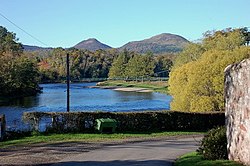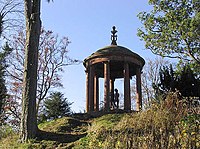Dryburgh
| Dryburgh | |
| Berwickshire | |
|---|---|
 The Tweed at Dryburgh | |
| Location | |
| Grid reference: | NT591321 |
| Location: | 55°34’44"N, 2°39’-0"W |
| Data | |
| Local Government | |
| Council: | Scottish Borders |
Dryburgh is a village in Berwickshire, standing on the east bank of the River Tweed which here marks the border with Roxburghshire. It is most famous for the ruined Dryburgh Abbey, whose remains stand in a loop in the river on the south side of the village.
Across the river is Newtown St Boswells, and beyond is Melrose, with its own ruined abbey, Melrose Abbey. The two are joined by two log-distance footpaths; St Cuthbert's Way and the Border Abbeys Way.
The Temple of the Muses

On Bass Hill, a mound overlooking the River Tweed at the west end of the village stands the Temple of the Muses, a circular nine columned gazebo built in 1817. It is dedicated to the poet James Thomson, the Ednam poet and author of "The Seasons" and the lyrics of Rule Britannia. His bust can be seen on the top of the structure.
The temple originally contained a stone statue of the Apollo Belvedere on a circular pedestal showing nine Muses with laurel wreaths. Bronze figures of the Four Seasons by Siobhan O'Hehir were installed as a replacement in 2002.
Outside links
| ("Wikimedia Commons" has material about Dryburgh) |
- Engraving of Dryburgh in 1693 by John Slezer at NLS
